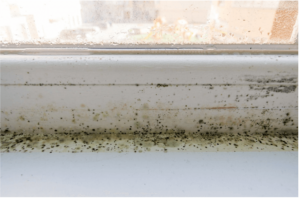
Most people aren’t aware that they have mold growing on their window sills. They think that those black spots and stains are just part of the natural wood grain.
Unfortunately, they aren’t. And keeping them there can not only cause damage to your windows but may even trigger allergic reactions or trouble breathing in people who are sensitive to mold.
In other words, if you notice mold scattered on your window sills, you’ve got a problem.
Lucky for you, that problem is about to end.
Because in this post, you’ll not only learn how to prevent mold from growing, but also learn how to remove mold that may already be sitting on your window sills.
Mold’s vacation ends today.
But first things first…
What is mold and how does it grow?
Mold is a type of fungus that consists of small organisms, typically found in moist and warm conditions. It causes the biodegradation of natural minerals, especially in food. Mold comes in different colors, too—including white, orange, green, brown, and black.
While small amounts of mold aren’t dangerous, once it starts to grow in bulk, mold makes windows look ugly and may compromise the air quality inside your home.
What makes it grow? Moisture.
Mold is a sucker for warm and damp places. While moisture can happen all year long, mold growth typically peaks during winter—when you close your windows for long periods of time, reducing the ventilation and circulation of the air in your home.
At the same time, the heat generated by your boiling kettle, hot shower, and home appliances increases the humidity level in your house. When it’s too high, condensation happens.
Since mold is a fungus, the dust that comes from dead skin cells, bacteria, and soil particles can start the birth of mold. Once this dust gets warm and wet, mold starts to grow.
And when it does, the next thing you need to do is remove it. The good news is that there are several ways to do that—and they cost next to nothing.
How to remove mold on your window sills
If you are looking for effective solutions that will not only remove mold but also prevent it from coming back, here are some remedies that you can try:
Clean your window sills with warm water and soap
Wipe your window sills thoroughly using a warm, damp cloth and soap. This should remove any dust and scattered pieces of rubbish from your window sills while preventing mold from existing and, worse, growing out of control.
Bleach
One of the most common products for cleaning is bleach. And here’s why:
Its active ingredient, sodium hypochlorite, is not only an excellent disinfectant but also a great antimicrobial agent that kills 99.9% of germs and bacteria.
How to use it:
- Use a ratio of one cup of bleach per gallon of water (i.e., about 1 part bleach to 10 parts water). If you want a stronger combination, mix 1 part bleach to 3 parts water.
- Apply the mixture using a spray bottle, sponge, or cloth.
- Let it dry by itself. You don’t need to wipe it with a dry cloth or rinse it.
Vinegar
No cleaning products? No problem. Just grab the distilled white vinegar from your kitchen and you already have a natural, non-toxic alternative to cleaning agents. Containing about 5-20% acetic acid, it pierces deep inside areas where the mold lives and prevents it from growing.
How to use it:
- Pour 1 cup of distilled white vinegar into a spray bottle.
- Spray the vinegar onto areas that have mold and leave it for about 30 minutes to 1 hour.
- Wipe the area with a damp cloth to remove the vinegar smell.
A quick warning: Vinegar may cause discoloration when used on tile surfaces, and it may dull natural stone materials such as marble and limestone. Keep these things in mind when using vinegar to clean your window sills.
Hydrogen Peroxide
Another alternative to bleach is hydrogen peroxide. It’s safer than bleach because it’s non-toxic and environmentally friendly. Because it is antibacterial, anti-fungal, and antiviral, it effectively kills mold growing on your window sills.
How to use it:
- Pour 3% concentration hydrogen peroxide into a spray bottle.
- Spray the hydrogen peroxide onto areas that have mold and leave it for about 10 minutes.
- Scrub the area with a non-abrasive scrub or sponge. This will remove all the mold and stains.
- Wipe the area with a clean cloth.
How to prevent mold from growing
While the steps mentioned above work well in preventing mold from growing, there’s still no lifetime guarantee that it will never come back. That said, the best way to prevent mold is to prevent (or control) moisture.
Use mildew-resistant paint
Painting your window sills with mildew-resistant paint will help; this type of paint resists water absorption and—you guessed it—prevents moisture from accumulating.
Regularly clean your window sills
It’s not enough to just clean your window sills once a year. Be sure to clean them periodically throughout the year (depending on how humid your house is) to prevent mold from becoming a problem. If you can, using the methods we shared earlier, try cleaning your window sills at least every quarter.
Install long-lasting and high-performance windows
Windows like Vinyl Horizontal Sliding Windows or Aluminum Horizontal Sliding Windows assist in preventing dust and moisture (as well as energy leakage). With these beautiful, durable, and high-performance windows, you’ll be able to significantly reduce your cleaning efforts and avoid potential health risks to you and your family.
Ready to replace your windows and keep mold at bay? As the largest window distributor in Arizona, XO Windows can help you get started with window replacement. We offer professional window installation for new home projects, as well as window replacements in existing homes.
Complete our FREE estimate questionnaire or call 602-455-6616 today.
